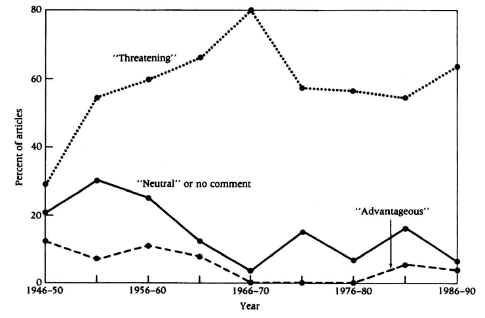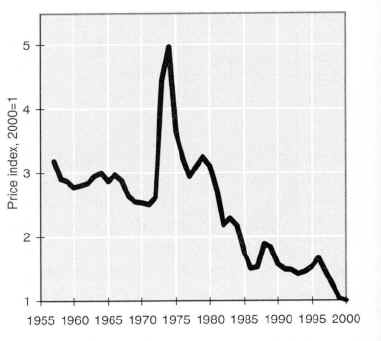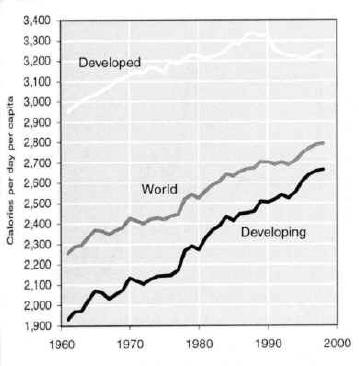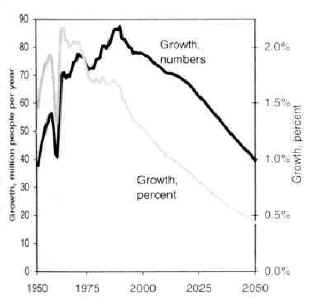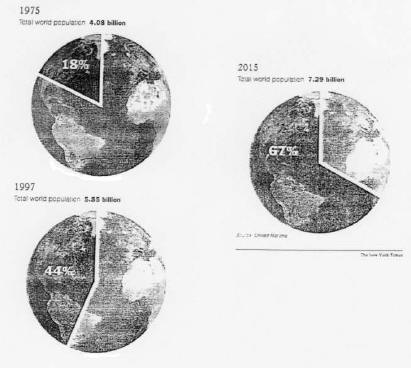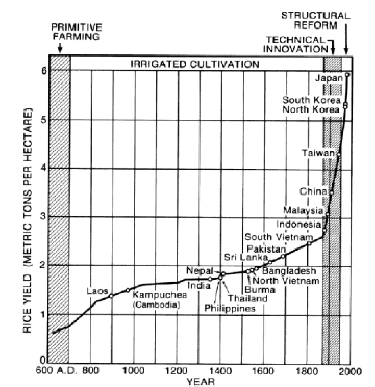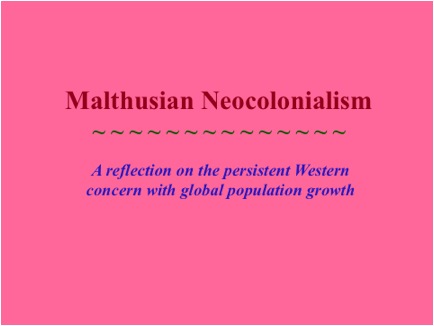Some Thoughts on "Overpopulation"
William S. Abruzzi
(2004)
In his book, The Population Bomb, published in 1968, Paul Ehrlich, a biologist, claimed that population growth would soon lead to mass starvation throughout the world. He saw this as inevitable. "The battle to feed all of humanity", he stated, "is over . . . hundreds of millions of people are going to starve to death." The earth, he claimed simply could not support the 6 billion people projected to exist by the year 2000. In a 1969 article titled "Eco-Catastrophe!", Ehrlich later stated that "by 1985 enough millions will have died to reduce the earth's population to some acceptable level, like 1.5 billion people." He also predicted that 200,000 people would die as a result of "smog disasters" in New York and Los Angeles by 1973, that the oceans would be devoid of fish by 1979 due to DDT poisoning, that U.S. life expectancy would drop to 42 years by 1980 as a result of pesticide-induced cancers, and that the U.S. population would decline to 22.6 million by 1999. In 1981, Erhlich even predicted that, largely as a result of human population growth, 250,000 species are becoming extinct every year (though he provided no data to support that claim), that half the species on earth would become extinct by the year 2000 and that no species would be left by the year 2025. At the same time, Norman Myers in his book The Sinking Ark (1979) claimed (also without providing any data) that 40,000 species were being lost each year, while E.O. Wilson, the author of Diversity of Life (1992) has at various times claimed (again without data) that between 27,000 and 100,00 species were going extinct each year. Former Vice-President Al Gore later repeated uncritically Myers' claim of 40,000 extinctions per year in his book, Earth in the Balance (1992).
(A critically important problem undermining all claims about declining species numbers is the fundamental inability to define species. Numerous methodological problems exist which make it impossible to distinguish species boundaries among neighboring and/or closely related populations. The most important of these problems is the fact that no single definition of species exists that can be to all living organisms. Consequently, it is not even possible to calculate species diversity within local ecological communities, let alone throughout the globe. See Abruzzi, A Temporary Convenience: A Critical Review of the Species Concept)
In 1972, the Club of Rome, an international think tank consisting of scientists, economists and others concerned about world problems, published a report entitled The Limits to Growth. Using computer models, the Club of Rome established specific dates at which the world would run out of critical resources. According to The limits to Growth, the resources listed below would be exhausted as follows:
| Copper
Gold Mercury Natural Gas
|
1993
1981 1985 1994 |
Lead
Petroleum Silver Tin
|
1993
1992 1985 1987 |
How could Ehrlich and others have dreamed up such preposterous predictions? In a 1992 review of over 500 articles that examined how the population issue was presented in American popular magazines between 1946 and 1990, John Wilmoth and Patrick Hall discovered that Paul Ehrlich was easily the most prolific writer on the subject, having had 24 articles published. The second most prolific author had only 17 articles published. At the same time, Ehrlich was among the most cited authors in all of the other articles written. Why was Ehrlich so influential in the population debate? Why were so many people so completely willing to accept his unrealistic scenarios of the future?
As the chart below clearly indicates, articles presenting a "threatening" view of population growth far outnumbered those that viewed population growth in either "neutral" or "advantageous" terms.
|
SOURCE: J.W. Wilmoth & P. Ball. 1992. "The Population Debate in American Popular Magazines, 1946-90." Population and Development Review 18: 640.
|
The chart to the left shows the percent of articles in American popular magazines between 1946 and 1990 that advanced either a "threatening", "neutral" or "advantageous" view of population growth. The "threatening" view of population growth consistently dominated the media, accounting for the majority of all articles published. |
Why were so many people convinced that population growth would inevitably lead to disaster, and why do so many people today continue to accept dire predictions concerning the effect that population growth will have on the future of humanity? Is there any historical evidence to support mass starvation and/or catastrophic environmental degradation as a result of population growth? Was there clear scientific research in the 1960s, when Ehrlich made his predictions, that the earth could not feed 6 billion people? Is there data which shows that human welfare has been declining during the past 50 years? What about the future? Is there clear evidence today that there is a food shortage in the world, that the earth cannot feed more people than currently exist, or that it can only do so with serious harm to the environment? Is there even data to show that world population is continuing to rapidly increase? Is there also credible scientific research that links poverty and underdevelopment to overpopulation? Frank Furedi, in his book Population and Development: A Critical Introduction, discusses what he sees as the "profound tension between the intuition that population growth has negative consequences for the living standards of developing societies, and the absence of empirical evidence to substantiate this sentiment. Furedi concludes, "when it comes to deciding on the impact of population growth, 'feelings' still tend to count more than facts."(p.35). Indeed, all we have to do is examine economic development in India and China over the past 30 years, compared to the rest of the world. While Ehrlich claimed in 1970 that India was poor because it was overpopulated, India currently experiences 7-- 8% annual growth in GNP (compared to 3.5% for the U.S., 2.1% for France and 1.5% for Germany), at the same time that its population of 555 million in 1970 nearly doubled to over one billion today. Similarly, China has consistently maintained the highest economic growth of any major country in the world -between 9 and 10% per year- while its population increased from about 820 million in 1970 to over 1.2 billion in 2000.
The following three charts, taken from The Skeptical Environmentalist by Bjorn Lomborg (2002) illustrate the problem with generalizations concerning the dire consequences of world population growth, including those made by Paul Ehrlich:
|
SOURCE: IMF 2001 (presented in Lomborg (2002:62)
World Bank Price Index for Foodstuffs 1957-2000. |
The chart to the left shows that the price of food on the global market has actually declined substantially over the past 40 years to where foodstuffs today cost, on average, less than one-third of what they cost in the 1950s. According to the principle of supply and demand, if there were more people than the food needed to feed them, the price of food should have increased. It should not have decreased, and certainly not by over two-thirds! The sharp increase in food prices during in the mid-1970s was a fluke, the result of the oil embargo imposed by OPEC in 1973. (Both fertilizer and pesticides are made from petrochemicals which, in turn, are made from oil.)
The chart also shows how important it is to view data over a long enough period of time. If someone, for example, had only observed food prices from 1965 to 1975, they would have seen a sharp increase in the price of food and very easily concluded that food prices were increasing as a result of overpopulation. How much of the concern for other contemporary issues, including global warming, results from not observing data over a long enough period of time? |
|
The chart to the right also raises questions about the dire claims made by Paul Ehrlich and others. The fact is, according to the best statistics available, nutritional standards throughout the world have been steadily improving over the past 40 years, during the same time that world population has been increasing. While local famines do occur, the reality is that they are not due to overpopulation, but rather to specific local conditions, usually involving political factors rather than environmental deterioration or the inability of people to feed themselves. By every single health statistic, world population, including the populations in developing countries, are better fed and freer from disease than at any time in its history. As Lomborg shows clearly in his book, most of the claims to the contrary are based on isolated situations, faulty data, a selective use of the data, or no data at all.
|
SOURCE: FAO 2001 (presented in Lomborg (2002:109)
Daily Intake of Calories per Capita in Industrial and Developing Countries and for the World as a Whole
|
|
Examining food production in India over the past several decades will illustrate the point made by Lomborg in the above chart. Average growth in agricultural output in India has exceeded 2.5% per year since 1950 and 3% during the more recent years. This rate of increase is more than double the rate that occurred from 1900 to 1950 when agricultural production increased by less than 1% per year. Significantly, most of the growth in overall crop production in India was the result of an increase in yields per hectare rather than an increase in the total number of hectares under cultivation. Yet, even with such significant increases in crop yields, India's level of agricultural production is dwarfed by that of the U.S., Europe, and Japan. Rice production per hectare in Japan, for example, is currently 3 times that of India (and twice that of China). This raises an interesting and important question: what impact will increasing agricultural production in India (or China) have on future global food prices if India (or China) continues to increase its level of food output? How will this affect international competition for global food markets, given that the rate of global population increase, which has been declining for over 40 years, is expected to continue to decline (see chart below)?
|
|
|
SOURCE: U.S.Census Bureau 2001 (presented in Lomborg (2002:47)
Percentage and Absolute Increases in World Population |
The chart to the left raises questions about claims of future population growth. What the chart shows is that the rate of population growth is actually decreasing and has been decreasing for several decades. The rate of population growth actually peaked in the early 1960s and has been decreasing every year since. The chart also shows that the increase in absolute numbers peaked in 1990 and has experienced a steady decline ever since. Predictions of future world population growth have notoriously had to be repeatedly revised downward due to the continued decline in the rate of population growth. In fact, there has been such a decline in fertility throughout the world that a majority of countries today maintain fertility rates that are at or below replacement. In addition, many countries, such as Japan and several of the European countries face the real prospect of absolute population decline in the next century, which is predicted to have serious economic consequences for the people in those countries.
|
|
The percentage of the countries whose fertility rate is at or below the replacement rate (2.1 children born per women by the end of her childbearing years) has been steadily increasing. According to United Nations figures, the proportion has increased from 18% in 1975 to 44% in 1997 and is expected to increase to 67% by the year 2015. Total fertility rate in the U.S. is 2.07. Significantly, the U.S. ranks 140 from the top of the total fertility list, which means that 75 countries have a lower fertility rate than the U.S., including Ireland (1.89), France (1.85), Taiwan (1.57), South Korea (1.56) Japan (1.38), Russia (1.33), Hong Kong (1.32), Italy (1.26) and Hungary (1.25). Even China's fertility rate, which is currently estimated at 1.7, is lower than that of the U.S.
|
|
Given that the above information is readily available and has been around for many years, how could Ehrlich and others have proposed (and still continue to propose) such outlandish and unrealistic visions of the future? Ehrlich states that his understanding of the "Population Bomb", as he called it, came to him one summer when he was in Delhi, India.

How much of Ehrlich's "epiphany" with regard to the "Population Bomb" was, in fact, based on a misunderstanding of the issue? It is perhaps significant that Ehrlich refers to his "emotional" understanding of what he viewed as the "population explosion". How much was he confusing overpopulation with poverty and, maybe, even a certain amount of "culture shock"? Would Ehrlich have had the same reaction and felt the same way about overpopulation if he were walking down either Broadway or Fifth Avenue in New York, rather than through the hot sweltering slums of Delhi? New York is, after all, a much larger and a much more densely settled city than Delhi? What about Tokyo, the largest city in the world? Would Ehrlich have reacted the same way while walking through downtown Tokyo? Tokyo is larger than either Delhi or New York. But what about the data? How could he have ignored the available data?
|
Downtown Manhattan |
The Tokyo Subway |
On the Streets of Tokyo |
Many of the measurable economic and demographic characteristics of social life in Europe, Japan and the United States during the late 19th and early 20th centuries were comparable to the circumstances that currently prevail in the developing world. Life expectancy in the U.S. in 1900, for example, was about 30 years of age, comparable to that in Nigeria today. Given this situation, there may be much truth to the following statement made by the late Julian Simon, former professor of economics at the University of Maryland:
"This is my long-run forecast in brief:
The material conditions of life will continue to get better for most people in most countries, most of the time, indefinitely. Within a century or two, all nations and most of humanity will be at or above today's Western living standards.
I also speculate, however, that many people will continue to think and say that the conditions of life are getting worse."
--Julian Simon (1997)
What is the relationship between population growth and economic development? Malthusians and Neo-Malthusians see population growth as a major hindrance to economic development and, therefore, as the principal cause of poverty and underdevelopment in the Third World. John Weeks is a neo-Malthusian sociological demographer. In his book, Population: An Introduction to Concepts and Issues, which is one of the largest selling college textbooks on population in the world, Weeks argues that population growth is one of the principal causes of underdevelopment in contemporary Africa. However, as part of his discussion, Weeks states that Sub-Saharan Africa had nearly 100 million people in A.D. 1500 (almost the same as Europe at the time). According to Weeks, Africa's population declined precipitously following European contact, while the populations of Europe and European derived countries (the U.S., Canada, Australia, etc.) increased dramatically. Furthermore, he states that Africa's population has only rebounded in the late 20th century, and still comprises only 11% of the total world population (compared to 17% in A.D.1500). Weeks' statements raise several issues regarding claims made by him and by others that African countries are overpopulated and that population growth is the primary factor causing poverty and underdevelopment throughout the African continent.
|
What are the implications of the fact that Africa's population declined after A.D.1500 while Europe's population increased? Who prospered more over the past five centuries: the people living on the continent whose population size decreased (Africa), or the people living on the continent whose population size increased (Europe)? Why did African population size decrease? What role did slavery and colonialism play in that decline? Who benefited from slavery: the African economies or the Euro-American economies?
The African population's proportion of world population has actually decreased since A.D.1500. Has Africa as a region shown greater or lesser economic development than other world regions as a result of its declining relative population size?
|
The Western view of Africa is most commonly and mistakenly that of a continent where the people are mired in poverty due to overpopulation. |
To what extent might our attempts to "blame" underdevelopment in Africa (and elsewhere) on population growth actually constitute an attempt to divert attention away from what many believe is the real cause of African underdevelopment --Western colonialism? (c.f., Rodney, How Europe Underdeveloped Africa) Western countries colonized the entire African continent and divided the land and the people among themselves. (Europeans did the same thing throughout Asia, South America, the Middle East and elsewhere.) Large areas of land were taken over by Europeans, and millions of people were forced to pay taxes and to work on European plantations, mines and other economic enterprises. However, what made African colonialism unique is that tens of millions of Africans were forcibly removed from their homes and sold into slavery, mostly in the U.S. What effect did the forcible removal of millions of people from Africa as slaves likely have on indigenous economies and on local social organization, community integrity and political stability? According to Non-Malthusian population theory, significant population decline alone would be expected to produce economic underdevelopment and a decline in indigenous political organization, which is exactly what happened.
In addition, we need to ask how the expropriation of African labor to support the colonial economy affected the ability of Africans to labor on their own farms and economic enterprises, or their ability to maintain viable communities and prosperous political economies? Who benefited from the wealth created by the many colonial agricultural, mining and manufacturing enterprises on which Africans worked --the African laborers and their communities, or the European colonialists and businesses who owned and operated them? Did the wealth these enterprises produced stay in Africa to generate African economic development, or did it flow to Europe to support European economic development? Finally, Africa has witnessed some 50 wars over the last several decades. These wars have caused death and destruction throughout the continent and have devastated local and national economies. To what extent are these wars a consequence of European colonialism, of the artificial national boundaries created by the European powers to serve their own interests, and of the failure of European governments to establish viable African political economies when they began to dismantled their colonial empires in the 1950s?
It is perhaps significant that the only non-Western country to become a major economic power in the 20th century was Japan, the one country that the West did not colonize. It is also significant that the rapid development of contemporary Asian economies, such as China, Korea and Taiwan, only occurred after they gained independence from their European colonizers, not after their population growth declined. Is it possible that the reason that neo-Malthusian population theory is so dominant in the West is that it provides a simplistic superstructural rationalization of contemporary international economic inequality that serves Western interests and that promotes Westerners' ethnocentric view of Western moral superiority (see Furedi 1996; Abruzzi 2002)?
|
Are there too many children in Africa, or does our perspective on African population reflect a Western bias? |
"The Malthusian motive: the will to control the population of the poor rather than the consumption of the rich; the desire to eliminate poverty by reducing the numbers of the poor rather than the inequalities of society. . . . If we claim that there are too many people on the earth, then why are we so sure that we are not the excess ones --we westerners who individually consume and pollute as much as 50 or more African or Indian peasants? In all my years in the field of population, I have never one single time heard a member of the population establishment say that there were too many upper-middle class white Anglo-Saxon Protestants in the world.
--Pierre Pradervand, "The Neo-Malthusian Myth." Africa Report (July/August)1974:34-37.
* * *
Does Pradervand's comment accurately reflect American attitudes and foreign policy with regard to family planning and population control in Africa, Asia and Latin America?
* * *
--see Abruzzi, Sociopolitical Implications of the Persistent Western Concern with Global Population Growth for a discussion of how population control theories and programs serve Western interests rather than the interests of the people at whom they are directed. |
If Europe and Africa had comparable sized populations in 1500, and if Africa is perhaps 10 times the size of Europe, why don't we consider Europe to have been "overpopulated" then? Also, since Europe's population has increased from 100 million in 1500 to about 400 million today, why don't we consider Europe even more "overpopulated" today than it was in the past? As the chart below clearly shows, Germany and Great Britain contain much larger populations and much higher population densities than the Congo, Ethiopia or Kenya --or even than Nigeria, the most populous country in Africa. Indeed, the population densities of Germany and Great Britain are about twice that of Nigeria, nearly 5 times that of either Ethiopia or Kenya and 30 times that of the Congo! Moreover, per capita energy consumption in Germany and Great Britain is almost 20 times that in the Congo, 42 times that in either Kenya or Nigeria and 240 times that in Ethiopia. Why then is it the African countries, such as Nigeria, Kenya, Ethiopia and the Congo that are considered "overpopulated" and in need of birth control and not Germany, Great Britain and the other European countries?
Significantly, per capita energy consumption in the U.S., according to the World Development Report, (see Table 1) is 8.076 (kg oil equivalent units) --about twice that of either Germany or Great Britain, over 16 times that of Kenya and 28 times that of Ethiopia. Think of how much of the world's resources we could conserve if we could stop Americans from having children! In terms of energy consumption, the energy consumed in the U.S. could support 4.5 billion Kenyans, over 7 billion Congolese and nearly 8 billion Ethiopians! At the same time, the U.S. population has been increasing quite rapidly --273% between 1900 and 2000. The U.S. population has also nearly doubled in size --150 million to 273 million-- since 1950. Why, then, do we hear so few people complain about population growth in the U.S., the most environmentally expensive population on the planet? Why is it that Americans are working much harder to stop population growth in Asia and Africa than in the U.S.?
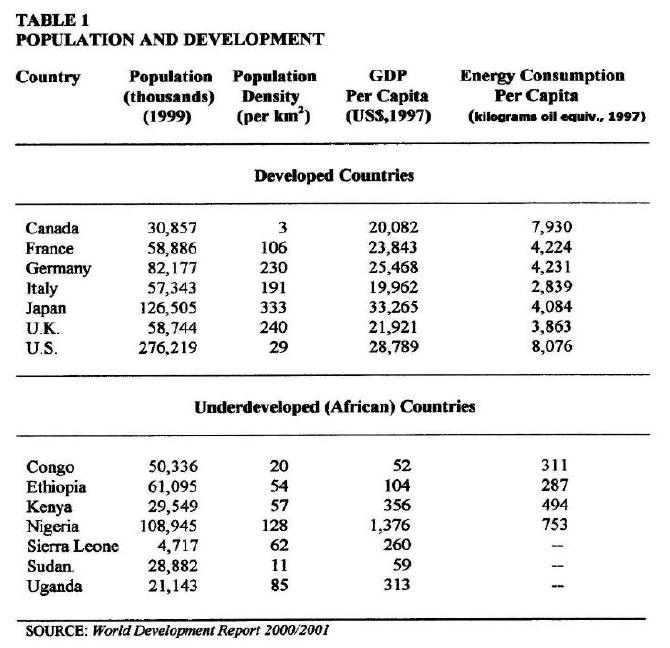
By comparison, population density in New Jersey is 437 people per km2.
On pages 24-26 of his book, Weeks states that in the 17th century (1600s) New England was characterized by very high birth rates. In one sample of 90 families, an average of 7-8 children per family grew to adulthood, compared to only 2-3 children in the South. In addition, he states that only about 3% of the population growth in the U.S. throughout the 17th and 18th centuries can be attributed to immigration; most of it was due to natural population increase. Indeed, he states that the crude birth rate in the U.S. was 55 births per 1000 population, "Comparable to the highest national birth rates in the world today." At the time, the U.S. population was doubling every 25 years. Indeed, The U.S. was singled out by Thomas Malthus as a country whose population was growing too rapidly. Weeks further states that, while contemporary American birth rates are low, the U.S. still maintains one of the highest population growth rates in the world --comparable to those of Zimbabwe in Africa and Thailand in Asia. These facts also raise important questions.
Birth rates in New England during the 17th century were as high --and in some cases higher-- than birth rates in contemporary Africa, where the highest birth rates presently exist. If population growth is supposed to be a hindrance to prosperity and economic development among developing countries today, why was it not a hindrance for the U.S.? The U.S. population increased from about 5 million in 1800 to 75 million in 1900 and to 280 million in 2000. That means that the U.S. population increased 1400% during the 19th century and 273% during the 20th century. How was the U.S. able to sustain such high birth rates and population growth rates, yet grow to become the wealthiest and most prosperous country in the world, if population growth is such a hindrance to prosperity and economic development? Why didn't the doubling of the U.S. population every 25 years cause the problems that it is supposed to be causing in developing countries today? How can we claim that population growth is a hindrance to economic development in the Third World, when the most prosperous country in the history of the world has sustained some of the highest growth rates ever recorded?
New England has historically had much higher birth and population growth rates than in the southern U.S. However, throughout American history, New Englanders have maintained a higher standard of living than Southerners. If population growth is a hindrance to economic development, then why is this true?
Except for the brief "Baby Boom" of the 1950's, the U.S. birthrate has declined steadily throughout the late 19th and 20th centuries. Why did this take place? Did the decline require massive family planning programs, or was it accomplished by millions of people making individual choices that served their best interests? Did the decline in fertility require new technology, or was it largely accomplished before the availability of modern birth control techniques? Why did the Baby Boom occur during the 1950s? Why did it then subside? What are the implications of accurately understanding the history of fertility in the U.S. (and in Europe and Japan) for evaluating family planning programs in the Third World? Do Africans and Asians need to be educated about the advantages of family planning? Aren't they able to figure out what is best for them on their own? Do they have to be told by outsiders? Paul Demeny, editor of Population and Development Review, one of the leading international journals dedicated to the study of population, has stated that the prevailing Western notion that peoples in Africa, Asia and Latin America are having more children than they need or want amounts to saying that "two billion people in the past 30 years were added to the world's population because their parents were too stupid to figure out what to do." Did American women need to be educated about the advantages of family planning? Are African and Asian women having larger numbers of children because they are ignorant or stupid? Were American women of previous centuries having large numbers of children because they were ignorant or stupid? Were American women in the 1950s who had more children more ignorant or stupid than the women of the 1920s and 1930s who had less children? Finally, might there be racist implications of Westerners (mostly white people) claiming that Africans, Asians and Latin Americans (i.e., people of color) need education and outside assistance to achieve what is in their best interests, while Europeans and Americans (i.e., whites) did not?

In Japan, a population half the size of the United States
lives on a land surface the size of southern California.
|
Similarly, Japan's population was about 40 million in 1900. Today it is over 128 million. This means that the Japanese population has increased over 200% in the past 100 years. Furthermore, those 128 million Japanese --that is, a population about 46% the size of the U.S. population-- live in a country smaller than the state of California. Average population density in Japan is 880 people per square mile, compared to 211 people per square mile in California and only 75 people per square mile in the U.S. as a whole. However, since Japan consists mostly of islands --63% of which is covered by forests-- the bulk of the Japanese population is actually concentrated on less than 50% of the country's total land area. This means that, in Japan, a population nearly half the size of the entire U.S. population effectively lives on a land surface less than half the size of California. Why, then, is Japan the second wealthiest country in the world and the country with the longest average life expectancy? According to neo-Malthusian population theory, it is the Japanese (not the Africans) who should be starving and living in abject poverty.
Japanese Rice Production A.D. 600 - 2000 Compared to Other Asian Countries Today.
Individual Asian countries are placed on the chart according to when Japan was producing rice at the level at which they are producing rice today. |
As these pictures of Japan show, much of Japan is unpopulated, despite the country's high population density.
As the chart to the left clearly shows, the level of agricultural productivity in Japan today is higher than that of any other Asian country. In most cases, Japan produces between two and three times as much rice per unit of land as do the other Asian countries. However, all of the other Asian countries (and the countries in Africa and Latin America, which produce less food per hectare than do the Asian countries) have the potential of achieving agricultural production levels comparable to those of Japan (and the other developed countries). If and when they do, the significantly greater amount of food that will be available on the world market will drive prices down (as has been happening over the past forty years due to countries like India and China becoming food exporting countries). Current food surpluses are already creating economic problems for American farmers, who are sitting on grain surpluses that can often only be sold at prices below what it cost to produce them. |
Another comparison of population density is also useful. At present, average population density worldwide is 45 people per km2 (117 people per sq. mile). If the entire population of the earth were living in Texas, the population density of Texas would be approximately 8,700 people per km2 (22,532 people per sq. mile). This is certainly much higher than that of New Jersey or Pennsylvania. However, it is less than the current population density of New York City, which is 9,003 people per km2 (23,317 people per sq. mile). Most people would certainly not consider New York City "unlivable". Indeed, for many, New York City is a highly desirable place to live. Over 17% of the land area of New York City consists of parks and playgrounds, and the city contains numerous internationally respected universities, museums, art galleries and theaters. The purpose for using this comparison, however, is not to suggest that most people would want to live in an area as densely settled as New York City, but rather to place the discussion of population density in perspective. The current world population would yield a New York City level population density if it was entirely concentrated in Texas. However, this would leave the entire rest of the planet completely unpopulated. There would be no people in New York or in New Jersey, Pennsylvania, California or any other state; no people in France, Germany and the rest of Europe; no people in Russia, China, India and all of Asia; and no one anywhere in South America, Africa or Australia (see map below).
|
|
![]()
There is an important lesson to be learned here in understanding the meaning of population density. Average population density is not a particularly useful measure, since population distribution is everywhere very uneven. For example, although Japan's population density is 11.5 times that of the United States, nearly two-thirds of the country is largely uninhabited. Similarly, half of the population of France occupies slightly more than 10% of the surface area of the entire country. Paris contains over 20,000 people per km2 (51,800 people per sq. mile), more than twice that of New York, while most of the French countryside contains less than 20 people per km2 (52 people per sq. mile). Thus, while the population density of France exceeds 100 people per km2, most of France is barely populated. The pictures below are typical of the scenery that prevails throughout most of southern France.
|
Population density can also be very misleading at a local level. As just mentioned, although the population density of New York City is 9,003 people per km2, 17% of the land in the city consists of parks and playgrounds. Similarly, large areas of Manhattan contain commercial properties that have little resident population. The same diversity of local population density can be seen in Japan as well. The total Tokyo-Yokohama Metropolitan area (cities and suburbs) population in the year 2000 was 33,413,000. The population of Tokyo proper was about 11 million people, giving the city a population density of 10,932 people per km2 (28,439 people per sq. mile). However, population density varied sharply from one locale to the next within the overall metropolitan area --from as low as 5,000 people per km2 to as high as 40,000 people per km2 (103,599 people per sq. mile).
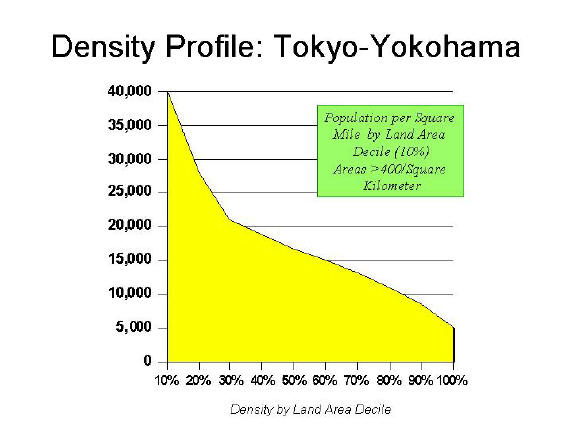
It is worth remembering that concerns over population growth are hardly new. People have been claming that population growth will cause disaster and the end of civilization for centuries. Thomas Malthus claimed some two centuries ago that population growth in England and Europe was out of control and would lead to a decline in living standards, if left unchecked. In fact, the populations of England and Europe today are nearly 10 times what they were in Malthus' day, and the standard of living and quality of life throughout England and Europe are among the highest in the world and completely beyond anything Malthus himself could have conceived.
But such concerns did not originate with Malthus. Numerous social commentators have expressed concern about the consequences of population growth. As early as the third century, The Roman Catholic scholar Quintus Tertullian (160-230 CE) viewed population growth as a threat to humankind.
The strongest witness is the vast population of the earth to which we are a burden and she scarcely can provide for our needs; as our demands grow greater, our complaints against nature's inadequacy are heard by all. The scourges of pestilence, famine, wars, and earthquakes have come to be regarded as a blessing to overcrowded nations, since they serve to prune away the luxuriant growth of the human race.
However, within the past 50 years, the intensity of the hysteria over population growth has increased substantially. During the 1950s and 1960s, population growth was largely blamed for poverty and underdevelopment in Africa and Asia. William Vogt, a sociologist, claimed in 1960,
China quite literally cannot feed more people … The greatest tragedy that China could suffer, at the present time, would be a reduction in her death rate. … Millions are going to die. … There can be no way out. These men and women, boys and girls, must starve as tragic sacrifices on the twin alters of uncontrolled reproduction and uncontrolled abuse of the land.
China has, instead, gone on to become the largest country in the world with one of the highest rates of economic development and with a rapidly increasing standard of living. It is about to overtake Japan as the second largest economy in the world, and is predicted to exceed the U.S. and become the largest economy in the world by around 2050.
Beginning in the 1970s, with the failure of Malthusian population theories to predict economic development, attention turned to blaming population growth for a deterioration of the natural environment. More recently, population growth has been presented as the underlying cause of "urban sprawl" in the U.S., violence and political instability around the world, and the subordination of women, among other things.
However, a very critical issue needs to be addressed: how accurately do the models of population growth employed by Malthusians and neo-Malthusians actually explain the evolution of modern urban industrial societies, including the demographic, economic and social conditions that prevail in Europe, Japan and the U.S. today, and do we have confidence that these same models will be accurate in predicting developments in the future? There is no data on the future, only data from the past. We, therefore, need to base our models of future population growth and its implications on a careful consideration of historical data. Does the historical data on population growth support the notion that the world is headed for disaster? . . .
Or does the whole literature on overpopulation have the feel of . . .
* * * * *
Here is an excerpt from an article in National Geographic that also undermines the common view that the earth is at the limits of being able to feed everyone:
"Feeding the Planet"
T.R. Reid,
National Geographic.
October 1998: 56-74.
...People have been debating the planet's carrying capacity at least since Socrates' day. Many experts, at many different points in history, have predicted that the world would soon be overpopulated, leading to famine and suffering on a gargantuan scale. So far, these predictions of disaster have all turned out to be wrong.
Exactly 200 years ago, when the world's population was nearing one billion, the British economist Thomas Malthus offered the most famous statement of the basic dilemma. Population, he said, must increase, because "the passion between the sexes is necessary and will remain." But food supplies could not possibly increase as quickly: "The power of population is infinitely greater than the power in the earth to produce subsistence for man."
Modern-day Malthusians have been, if anything, even bleaker. A quarter of a century ago Paul Ehrlich, a leader of the global environmental movement, warned that our world was on the verge of "famines of unbelievable proportions." The population was about 3.5 billion, which Ehrlich believed was the limit. Feeding six billion people, he wrote in 1976, "is totally impossible in practice."
Next year the world's population will reach six billion--and human beings overall are better fed than ever before. Thirty years ago, according to the United Nations, the global food supply represented 2,360 calories per person per day. By the mid-1990s total food supply had increased to 2,740 calories per person per day. Supply will continue to grow faster than population at least through 2010, the UN predicts.
The big jump in population in the second half of this century has created much greater demand for food. But supply has increased even faster than demand, and the price of staple foods has fallen dramatically. Over the past 40 years the price of wheat, in constant dollars, has declined by 61 percent; the price of corn has dropped 58 percent....
And yet hundreds of millions of people do not get the 2,200 calories per day generally accepted as the nutritional bottom line. About 20 percent of the developing world's population is chronically undernourished; 30 years ago the percentage was twice that high, so we're making progress. But why must anyone go hungry?
The problem is not production but distribution. Local food supply often has little to do with natural conditions. Some of the best-fed people live in countries--Japan, for example--that don't have enough land to grow their own food. Some people who live in green meadows washed by regular rainfall are hungry. A major reason for the disparity between haves and have-nots is politics. Most of the world's governments have the political will to assure their people the basic elements of a reliable food supply. But some don't....
The relationship between politics and food supply is reflected in the late 20th-century downs and ups of China, which has more mouths to feed than any nation on Earth. During Mao Zedong's Great Leap Forward of the late 1950s, China was ravaged by famines that killed tens of millions and reduced average calorie intake far below the recommended level. Today, with a market-oriented economy that has produced the world's highest growth rates, some Chinese have a different food problem.
"It's amazing to say, but our problem is becoming overnutrition," says Ho Zhiqian, a friendly, talkative nutrition expert on the government's National Food Advisory Commission. "Today in China obesity is becoming common. We have more diabetes than the United States. Breast cancer is multiplying. I believe these are related to consumption of animal fat--you know, eggs, meat, butter--as a normal part of the daily diet."
"Today's increasingly prosperous China can afford meat. The Chinese already eat about as much pork per capita as Americans do; chicken and beef consumption is also climbing fast. This changing diet has forced big changes in Chinese agriculture. To meet the needs of 1.2 billion consumers, the nation is moving away from the traditional communal plots to Western-style agribusiness."
* * * * *
Additional Readings
Boserup, E., 1965. The Conditions of Agricultural Growth: The Economics of Agrarian Change under Population Pressure. Aldine-Atherton, Chicago.
Cohen, M. 1977. The Food Crisis in Prehistory: Overpopulation and the Origins of Agriculture. New Haven: Yale University Press.
Culbertson, 1971. Economic Development: An Ecological Approach. New York: Knopf.
Ellen, R. 1982. Environment, Subsistence and System: The Ecology of Small-Scale Social Formations. Cambridge: Cambridge University Press.
Furedi, F., 1997. Population and Development: A Critical Introduction, St. Martin’s Press, New York.
Hartmann, B. 1987. Reproductive Rights and Wrongs: The Global Politics of Population Control & Contraceptive Choice. New York: Harper & Row.
Kleinman, D.S. 1980. Human Adaptation and Population Growth: A Non-Malthusian Perspective. Montclair, NJ: Allanheld, Osmun & Co.
Lomborg, B., 2001. The Skeptical Environmentalist, Cambridge University Press, Cambridge.
Murdoch, W. 1980. The Poverty of Nations: The Political Economy of Hunger and Population. Baltimore: Johns Hopkins University Press.
Polgar, S. 1975. Population, Ecology and Social Evolution. The Hague: Mouton.
Simon, J. 1977. The Economics of Population Growth. Princeton, Princeton University Press.
Tiffen, M., M. Mortimore and F. Gichuki, 1994. More People, Less Erosion: Environmental Recovery in Kenya, J. Wiley, New York.
Turner, B.L. Hyden, G.L. and Kates, R.W., 1993. Population Growth and Agricultural Change in Africa, University Press of Florida, Gainesville.
* * * * *
Considerable controversy has surrounded the publication recently of Bjorn Lomborg's The Skeptical Environmentalist. Lomborg, a Danish statistician and former member of the Green Party, argues that the negative image of the "state of the earth" portrayed by western environmentalists and by the media is not supported by the available scientific data. Lomborg is especially critical of those environmentalists, such as Paul Ehrlich and Lester Brown, and of environmental organizations such as the World Wildlife Fund (WWF) and Greenpeace, for proclaiming what he terms is a "litany" of environmental warnings and predictions that: (1) are largely exaggerated, (2) are based on either faulty, selective, or misrepresented data --or no data at all, and (3) do not hold up under rigorous statistical or scientific analysis. The significance of Lomborg's argument derives from the fact that The Skeptical Environmentalist is carefully and meticulously researched. The book is 515 pages long and contains 2,930 detailed footnotes and over 1,800 bibliographic references. The irony of the book is that Lomborg began his research in order to challenge the very arguments the book puts forth. The Economist, a highly-respected British publication ran several reviews of Lomborg's book in its February 2, 2002 edition. These (plus a few additional) reviews can be accessed by clicking on the book image below.
